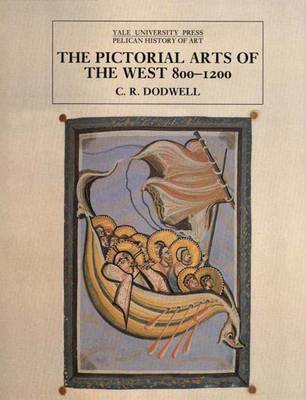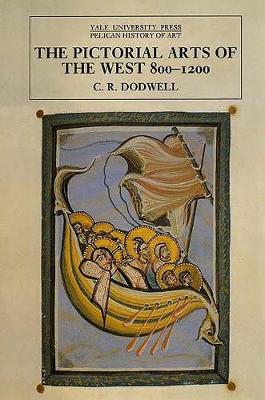The Yale University Press Pelican History of Art
3 total works
The subject of this text is painting in Europe between about A.D. 800 and 1200. At the ouset of the period, there was a danger of art being completely eclipsed from the European scene. By its conclusion, art was completely assimilated into the cultural life-blood of the West. In the period between, Europe witnessed the rise and development of some of the great styles of the Middle Ages: Carolingian art with a splendour of illumination exactly appropriate to an Emperor's court but boasting also drawings of such delicacy and finesse that they have been copared in quality to those of Leonardo: Ottonian art which evinces a self-confident power and authority and which is by no means unconscious of how art could be used for political as well as spiritual purposes: the colourful Mozarabic art of Spain which is given added vigour by its "barbaric" Visigothic antecedent and which reminds us by its preoccupation with the Apocalypse that this was a country still occupied by the Arab Infidel: the art of italy, continually controversial and continually interesting as it struggles from the embrace of the East towards the calls of the West and, in the process, produces many masterpieces.
Finally, in the 12th century, we find an international Romanesque style extending from the Scandinavian countries in the north to Jerusalem and Cyprus in the south. This is a style of trmendous clarity and vitality and one in which the whole of Christian Europe could for the first time find complete expression and identity. In this book, the author deals with all aspects of painting - wall-paintings of manuscripts, and he includes also stained glass windows and even embroidery. Whilst attempting to be as comprehensive as possible, his aim has been to represent the "bone-structure" of the period rather than to confuse by dwelling overmucyh on detail. Many of his ideas are new and a good deal of this book is based on his own researches.
Finally, in the 12th century, we find an international Romanesque style extending from the Scandinavian countries in the north to Jerusalem and Cyprus in the south. This is a style of trmendous clarity and vitality and one in which the whole of Christian Europe could for the first time find complete expression and identity. In this book, the author deals with all aspects of painting - wall-paintings of manuscripts, and he includes also stained glass windows and even embroidery. Whilst attempting to be as comprehensive as possible, his aim has been to represent the "bone-structure" of the period rather than to confuse by dwelling overmucyh on detail. Many of his ideas are new and a good deal of this book is based on his own researches.
Between the ninth and the 13th centuries the Western world witnessed a flowering of the pictorial arts. In this book the author provides a guide to all forms of this art - from wall and panel paintings to stained glass windows, mosaics and embroidery - and sets them against the historical and theological influences of the age. Dodwell describes the rise and development of some of the great styles of the Middle Ages: Carolingian art, which ranged from illuminations to drawings; Anglo-Saxon art; Ottonian art; the Mozarabic art of Spain; and the art of Italy influenced by the styles of Byzantium and the West. Dodwell concludes with an examination of the universal Romanesque style of the 12th century that extended from the Scandinavian countries to Jerusalem. His book also includes a discussion of the painters and craftsmen of the time and incorporates the latest research.
Between the ninth and thirteenth centuries the Western world witnessed a glorious flowering of the pictorial arts. In this lavishly illustrated book, C.R. Dodwell provides a comprehensive guide to all forms of this art—from wall and panel paintings to stained glass windows, mosaics, and embroidery—and sets them against the historical and theological influences of the age.
Dodwell describes the rise and development of some of the great styles of the Middle Ages: Carolingian art, which ranged from the splendid illuminations appropriate to an emperor's court to drawings of great delicacy; Anglo-Saxon art, which had a rare vitality and finesse; Ottonian art with its political and spiritual messages; the colorful Mozarabic art of Spain, which had added vigor through its interaction with the barbaric Visigoths; and the art of Italy, influenced by the styles of Byzantium and the West. Dodwell concludes with an examination of the universal Romanesque style of the twelfth century that extended from the Scandinavian countries in the north to Jerusalem in the south. His book—which includes the first exhaustive discussion of the painters and craftsmen of the time, incorporates the latest research, and is filled with new ideas about the relations among the arts, history, and theology of the period—will be an invaluable resource for both art historians and students of the Middle Ages.
Dodwell describes the rise and development of some of the great styles of the Middle Ages: Carolingian art, which ranged from the splendid illuminations appropriate to an emperor's court to drawings of great delicacy; Anglo-Saxon art, which had a rare vitality and finesse; Ottonian art with its political and spiritual messages; the colorful Mozarabic art of Spain, which had added vigor through its interaction with the barbaric Visigoths; and the art of Italy, influenced by the styles of Byzantium and the West. Dodwell concludes with an examination of the universal Romanesque style of the twelfth century that extended from the Scandinavian countries in the north to Jerusalem in the south. His book—which includes the first exhaustive discussion of the painters and craftsmen of the time, incorporates the latest research, and is filled with new ideas about the relations among the arts, history, and theology of the period—will be an invaluable resource for both art historians and students of the Middle Ages.


